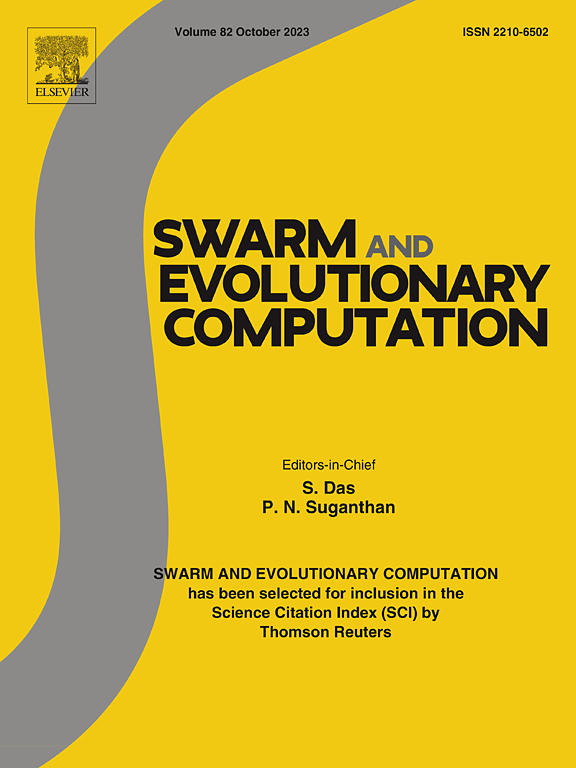Hybrid MOEA with problem-specific operators for beam-hopping based resource allocation in multi-beam LEO satellites
IF 8.5
1区 计算机科学
Q1 COMPUTER SCIENCE, ARTIFICIAL INTELLIGENCE
引用次数: 0
Abstract
The efficient allocation of satellite communication resources has become increasingly vital due to the dynamic and growing nature of traffic demand. The beam-hopping resource allocation technique addresses this challenge by enabling sequential and adaptive beam illumination, along with a dynamic distribution of power and bandwidth based on existing user demand. This work formulates the large-dimensional and highly constrained beam-hopping problem for low-power, low earth orbit satellites as a multi-objective optimization problem. It considers three key objectives: unserved capacity (UC), which measures the portion of traffic demand that remains unmet; extra served capacity (EC), which reflects excess traffic delivered beyond the requested demand, indicating possible inefficiencies; and time to serve (TTS), which represents the average waiting time for users in non-illuminated cells. Aiming at innovating in optimization, specialized initialization, crossover, mutation, and local search operators for multi-objective evolutionary algorithms (MOEAs) have been proposed. Performance is assessed through Hypervolume (HV) metrics and statistical confidence analysis. An extensive experimental analysis is presented first for a canonical NSGA-II algorithm, characterizing the impact of the new operators and hybrid components on performance. Then, beyond Pareto-based approaches such as NSGA-II, a study of both decomposition- and indicator-based MOEAs, namely MOEA/D and SMS-EMOA is assessed, demonstrating the generalizability of the presented approach. Compared to previous results in the literature, our hybrid approaches achieve up to 5% improvement in UC, up to 100% gains in EC, and up to 60% improvement in TTS for the best configuration.
多波束低轨道卫星中基于跳波束的资源分配
由于通信需求的动态性和增长性,卫星通信资源的有效配置变得越来越重要。跳波束资源分配技术通过实现顺序和自适应波束照明,以及基于现有用户需求的功率和带宽动态分布,解决了这一挑战。本文将低功率低地球轨道卫星的高维高约束波束跳变问题表述为一个多目标优化问题。它考虑了三个关键目标:未服务容量(UC),衡量仍未满足的交通需求的部分;额外服务容量(EC),反映超出要求的流量,表明可能效率低下;服务时间(TTS),表示用户在非照明小区的平均等待时间。针对多目标进化算法在优化方面的创新,提出了多目标进化算法的初始化、交叉、变异和局部搜索算子。通过Hypervolume (HV)指标和统计置信度分析来评估性能。本文首先对典型的NSGA-II算法进行了广泛的实验分析,描述了新算子和混合组件对性能的影响。然后,除了基于pareto的方法(如NSGA-II)之外,还评估了基于分解和基于指标的MOEA(即MOEA/D和SMS-EMOA)的研究,证明了所提出方法的普遍性。与文献中先前的结果相比,我们的混合方法在最佳配置下实现了高达5%的UC改进,高达100%的EC增益,以及高达60%的TTS改进。
本文章由计算机程序翻译,如有差异,请以英文原文为准。
求助全文
约1分钟内获得全文
求助全文
来源期刊

Swarm and Evolutionary Computation
COMPUTER SCIENCE, ARTIFICIAL INTELLIGENCEC-COMPUTER SCIENCE, THEORY & METHODS
CiteScore
16.00
自引率
12.00%
发文量
169
期刊介绍:
Swarm and Evolutionary Computation is a pioneering peer-reviewed journal focused on the latest research and advancements in nature-inspired intelligent computation using swarm and evolutionary algorithms. It covers theoretical, experimental, and practical aspects of these paradigms and their hybrids, promoting interdisciplinary research. The journal prioritizes the publication of high-quality, original articles that push the boundaries of evolutionary computation and swarm intelligence. Additionally, it welcomes survey papers on current topics and novel applications. Topics of interest include but are not limited to: Genetic Algorithms, and Genetic Programming, Evolution Strategies, and Evolutionary Programming, Differential Evolution, Artificial Immune Systems, Particle Swarms, Ant Colony, Bacterial Foraging, Artificial Bees, Fireflies Algorithm, Harmony Search, Artificial Life, Digital Organisms, Estimation of Distribution Algorithms, Stochastic Diffusion Search, Quantum Computing, Nano Computing, Membrane Computing, Human-centric Computing, Hybridization of Algorithms, Memetic Computing, Autonomic Computing, Self-organizing systems, Combinatorial, Discrete, Binary, Constrained, Multi-objective, Multi-modal, Dynamic, and Large-scale Optimization.
 求助内容:
求助内容: 应助结果提醒方式:
应助结果提醒方式:


